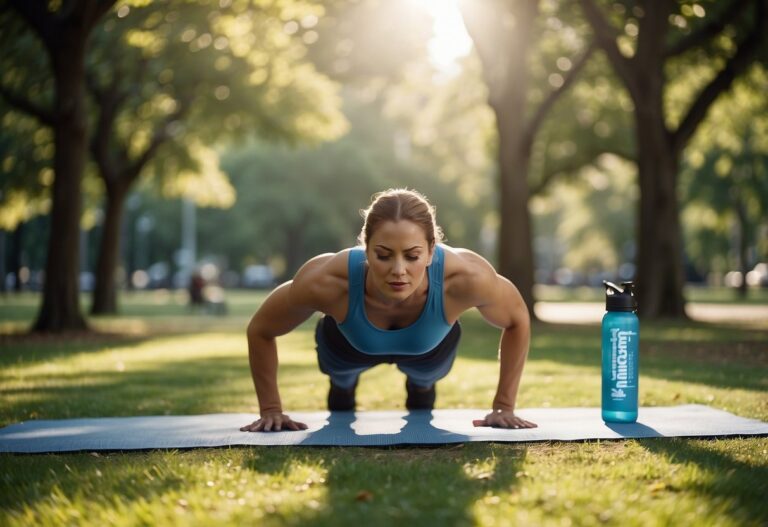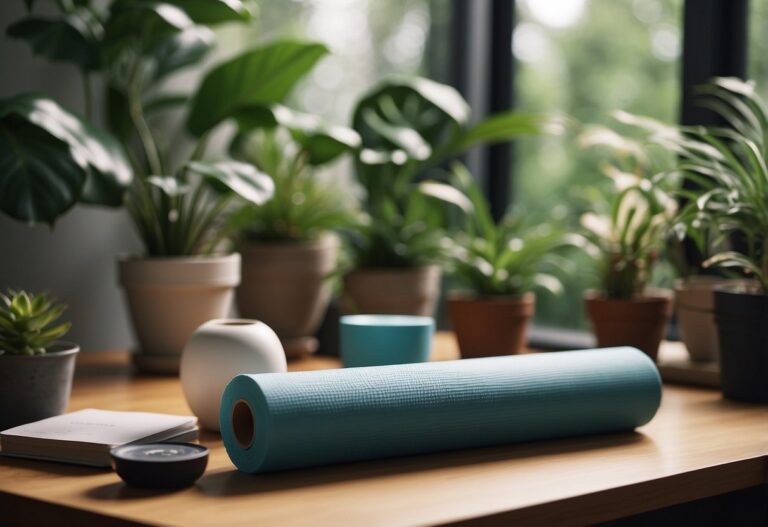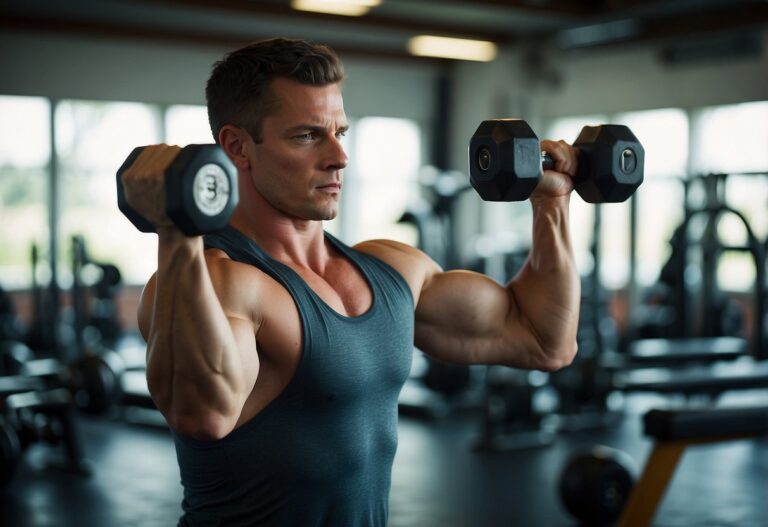Dumbbells are a versatile and accessible piece of equipment for anyone looking to enhance their fitness routine. Whether you’re a beginner or a seasoned gym-goer, dumbbells can offer a range of exercises to target different muscle groups effectively. But how can you make the most out of your dumbbell workouts for maximum results?

In this article, we will explore various tips to help you optimise your dumbbell workouts. From choosing the right weight to understanding proper form, these insights can help you achieve your fitness goals more efficiently and safely. With the right approach, you can elevate your workout regimen and see noticeable improvements in your strength and conditioning.
Perfect Form Dumbbell Rows
To start, stand next to a bench with a dumbbell beside it. Place your non-rowing hand and same-side knee on the bench. Your other foot should be firmly on the ground.
Keep your back flat and your chest up. Hold the dumbbell with a neutral grip, making sure your palm faces your body. Bend your elbow and pull the dumbbell towards your torso.
Lower it back down in a controlled motion. Aim for 8-10 reps on each side. For more details, check out this guide on dumbbell rows.
Seated Dumbbell Press
The seated dumbbell press is a great exercise for building shoulder strength.
Start by sitting on a bench with a back support. Set the bench to 90 degrees if it is adjustable. Hold a dumbbell in each hand at shoulder level. Make sure your palms are facing forward.
Use a controlled motion to press the dumbbells above your head until your arms are fully extended. Lower the weights slowly back to shoulder height. Keep your core engaged to support your back during the lift.
This exercise targets the deltoids, triceps, and upper chest. It is essential to use proper form to avoid injury and get the most out of your workout.
Renegade Rows
Renegade rows are a fantastic full-body exercise that works your core, back, and arms. To start, get into a plank position with a dumbbell in each hand. Keep your feet wider than shoulder-width apart for better balance.
Next, row one dumbbell to your side while keeping your core tight and hips stable. Lower the dumbbell and repeat on the other side. This movement helps build core strength and upper body endurance.
Remember to keep your body straight and avoid twisting your torso. This exercise combines the benefits of a plank and a row for a challenging workout. If you’re new to this move, start with lighter weights. Check out more details on renegade rows at Breaking Muscle.
Goblet Squats
Goblet squats are a fantastic exercise to add to your routine. They target your quadriceps, hamstrings, and glutes, making them great for your legs.
To do a goblet squat, hold a dumbbell close to your chest. Stand with your feet shoulder-width apart and toes pointing slightly outward. Keep the dumbbell vertical and grip it with both hands.
As you squat down, push your hips back and bend your knees. Go down until your thighs are parallel to the floor. Then, push through your heels to stand up again. Remember to keep your core tight and back straight.
If you perform goblet squats correctly, you will feel the burn in your legs and core. This exercise also helps improve your squat form, making it perfect for beginners. Next time you hit the gym, give goblet squats a try!
Dumbbell Deadlifts
Dumbbell deadlifts are a great way to strengthen your entire body. You start by grabbing a pair of dumbbells and standing with your feet hip-width apart. Make sure your toes point forward.
Hold a dumbbell in each hand with your arms extended in front of your thighs. Your palms should face your body. This helps you keep a firm grip during the lift.
As you begin the movement, push your hips back and soften your knees. Lower the dumbbells towards your shins. Keep your back straight and your chest up to avoid any strain on your spine. This form is crucial for preventing injuries.
Incorporating dumbbell deadlifts into your routine can also help improve your posture and core strength.
Arnold Press
The Arnold Press is a brilliant exercise for targeting your shoulder muscles. Named after the famous bodybuilder Arnold Schwarzenegger, it’s very effective.
To begin, hold a pair of dumbbells at shoulder height. Keep your palms facing your body. In one smooth motion, push the dumbbells overhead while rotating your palms to face forward.
This movement not only works the front delts but also engages the side delts and triceps. It’s great for adding variety to your shoulder workouts. If you’re looking for a challenge, try a single-arm Arnold Press. This can help you improve your balance and stabilisation.
For more details, refer to this guide on Arnold Press.
Dumbbell Flyes
Dumbbell flyes are a great exercise to target your chest muscles. They help in strengthening and stretching your pecs.
To start, lie on a flat bench with a pair of dumbbells. Position the dumbbells above your chest with palms facing each other.
Lower the weights slowly to your sides with a slight bend in your elbows. Pause briefly when your arms are parallel to the ground then bring the dumbbells back to the starting position in a controlled manner.
Keep the movement slow and steady to avoid injuries. Dumbbell flyes are best performed with lighter weights to maintain proper form and prevent strain.
Split Squats
Split squats are a fantastic exercise for building leg strength and balance. To get started, stand with a dumbbell in each hand and position your feet in a split stance. This means one foot in front of the other.
Lower your body by bending both knees. Your back knee should almost touch the ground. Keep your upper body straight and your core engaged. Push through your front foot to return to the starting position.
It’s important to keep your weight evenly distributed. This helps avoid injury and ensures both legs work equally. Remember to switch legs to get a balanced workout.
Doing split squats regularly can improve your lower body strength and stability. If you’re looking to take your leg day to another level, this exercise is a great choice. Check out more tips and videos on doing dumbbell split squats.
Single-Leg Romanian Deadlifts
Single-leg Romanian deadlifts are a fantastic exercise for targeting your hamstrings and glutes. They also help improve balance and core strength.
To perform this move, start by pushing your hips back. Your hips should move similarly to a regular deadlift.
Keep your back straight and avoid arching or rounding it.
As you bend at the hips, lift your non-working leg straight behind you. Make sure not to let it deviate to the side.
Remember, keep the weight close to your body to maintain good form and avoid common mistakes like spinal flexion or locking your knees.
This exercise is great with dumbbells, kettlebells, or even just your bodyweight. For more details, check out this guide on the single-leg Romanian deadlift.
Dumbbell Pullovers
The dumbbell pullover is a versatile exercise that targets your chest and back muscles, especially the lats and pecs.
First, lie down on a flat bench with your back, neck, and head fully supported. Hold a dumbbell with both hands, gripping the inner plate or the handle.
Extend your arms straight up towards the ceiling with your palms facing each other. Keep a slight bend in your elbows.
Slowly lower the dumbbell over your head, maintaining the bend in your elbows. Feel the stretch in your chest and lats.
Once you reach a comfortable stretch, bring the dumbbell back to the starting position. Remember to exhale as you lift.
For an added challenge, try positioning your upper back across the bench instead of laying flat. This variation engages your core more intensely.
Keep your movements controlled and avoid rushing through the exercise. Form is crucial to prevent injuries and maximise benefits.
Dumbbell pullovers are great for improving upper body strength and flexibility. Consider incorporating them into your routine for balanced muscle development.
The Benefits of Using Dumbbells
Dumbbells are a versatile and effective tool for a wide range of fitness goals. They help you build muscle mass, improve balance and coordination, and enhance joint health. Below, we’ll delve into how each of these benefits can positively impact your workout routine.
Building Muscle Mass
Dumbbells are great for building muscle mass because they allow you to target specific muscle groups. By lifting heavy dumbbells, you can perform exercises like bench presses, squats, and deadlifts, which are essential for muscle growth. Unlike machines that may limit your range of motion, dumbbells let you move naturally, engaging more muscles.
Because of their flexibility, dumbbells can cater to all fitness levels. Whether you are just starting out or are more advanced, you can adjust the weight according to your strength. Consistent use can lead to noticeable muscle gains and improved overall strength.
Improving Balance and Coordination
Using dumbbells can also improve your balance and coordination. When performing exercises such as lunges or single-leg deadlifts, you’re forced to stabilise your body, which engages your core and improves your balance. This kind of training is particularly beneficial for athletes or anyone looking to enhance their overall physical stability.
Moreover, dumbbell exercises often require both sides of your body to work independently. This means weaker muscles cannot rely on stronger ones, leading to better muscle symmetry and coordination. Dumbbell squats are a great example of an exercise that challenges and improves balance while strengthening the lower body.
Enhancing Joint Health
Another benefit of dumbbell workouts is their positive impact on joint health. Dumbbells allow for a more natural range of motion compared to barbell or machine exercises. This natural movement can reduce stress on your joints and decrease the risk of injury. For instance, when doing a dumbbell chest press, your wrists, elbows, and shoulders can move more freely than with a barbell press.
Engaging in strength training with dumbbells helps to strengthen the muscles surrounding your joints, providing better support and reducing the load on the joints themselves. This can be particularly beneficial for individuals with joint issues or those looking to prevent joint problems as they age.
Proper Form and Technique
When working out with dumbbells, it’s essential to use the correct form to prevent injury and maximise effectiveness. Key areas to focus on include grip positions and stabilising your core.
Correct Grip Positions
Using the correct grip is crucial for working out with dumbbells. There are mainly two grips: overhand (pronated) grip and underhand (supinated) grip. For most exercises, you will hold the dumbbells with your palms facing down (overhand) or up (underhand).
For example, in a dumbbell front raise, you should hold the dumbbells with an overhand grip. Keep your thumbs wrapped around the handles to ensure a secure hold.
When doing curls, use an underhand grip to target your biceps effectively. Holding dumbbells incorrectly can lead to strain and injury. Make sure your wrists stay straight and avoid bending them.
Experiment with different grip positions to target various muscles. Always ensure the grips are comfortable and avoid excessive squeezing to prevent fatigue.
Stabilising Your Core
A strong core is essential for maintaining balance and control during dumbbell exercises. Core stability helps protect your spine and enhances your strength. Engage your core by pulling your belly button towards your spine.
For seated exercises, keep your back pressed firmly against the bench. While standing, slightly bend your knees, and maintain a neutral spine. This provides support and reduces the risk of injury.
Incorporate core-specific exercises like planks and Russian twists into your routine. This will improve your overall stability and support your workouts with dumbbells.
Remember, stabilising your core is not just about crunches. It’s about engaging these muscles in every movement. This helps you perform exercises more efficiently and with better form.
Common Mistakes to Avoid
When working out with dumbbells, it’s easy to make some common mistakes. These can lead to injury or less effective workouts. Here we’ll look at two big ones: using weights that are too heavy and not using the correct range of motion.
Using Too Heavy Weights
A major mistake is choosing weights that are too heavy. Lifting excessively heavy weights can cause poor form and increase the risk of injury. When you’re struggling to lift, your body may compensate by using muscles that shouldn’t be involved. This can strain your back, shoulders, and joints, leading to long-term problems.
Stick to a weight that allows you to complete all your reps with good form. It’s important to feel challenged, but you shouldn’t sacrifice your technique. Aim to increase weights gradually as you build strength. This approach helps prevent injury and improves muscle growth over time.
Incorrect Range of Motion
Another common mistake is not using the full range of motion. This happens when you don’t move the dumbbells through the complete arc that the exercise requires. For example, during a dumbbell row, if you don’t bring the weight all the way up or let it fully extend down, you’re not engaging your muscles properly.
The dumbbell row should have your arms extending fully and then pulling all the way back, keeping your back straight and core engaged. Performing exercises with partial movements may seem easier, but it’s less effective. Full range of motion ensures that you work your muscles completely and evenly, leading to better strength and growth.
Attempting exercises with improper range can also lead to muscle imbalances and joint issues. Make sure to perform each movement slowly and deliberately, focusing on the quality of each rep rather than rushing through your set.







